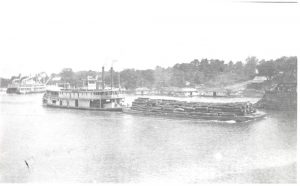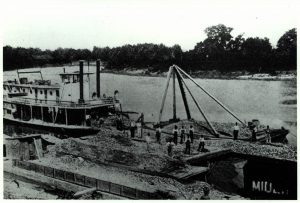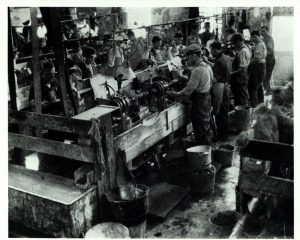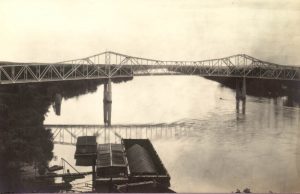Bicentennial 2018: Illinois rivers helped feed economic growth in state
By Joseph Bustos Of the Belleville News-Democrat — April 24, 2018During the first century of the state’s history, the natural habitats along the Illinois River helped spur fishing industries and had places for hunting.
The Illinois River was a habitat for bottom-feeding fish such as catfish, common carp and smallmouth buffalo as well as mussels. The abundance of fish led to a commercial fishing industry between Havana and Meredosia, according to the state museum. Towns had their own markets that processed and shipped fish to large Midwestern and Eastern cities from the 1890s to the 1950s.
Sport hunters formed clubs and bought land along the Illinois River to start duck hunting resorts managed by locals, according to the state museum.
However, there also was a demand to be able to transport goods, which changed life along the river.
Reports in the 1830s said the river wasn’t navigable in 70 to 80 places during the low-water months. A canal was eventually built between LaSalle and Chicago.
“The canal was instrumental in Chicago’s growth,” said Michael Wiant, the interim director for the Illinois State Museum. “There’s a recognition there, navigability on the river would give vitality to the economy of Illinois.”
Towns along the Illinois River, such as Naples, Grafton, Peoria and Beardstown, are the earliest communities in the region to be established. Ottawa had deposits of silica sand, that would be transported into Chicago for construction.
“You could begin to see the river as an artery that literally feeds the heart of the city,” Wiant said.
Levees eventually were built along waterways to keep the river in place, and maintain a channel. That infrastructure decision also eventually drained floodplains and backwater habitats, which led to those areas becoming land for row-crop agriculture
“The river is largely, by the early part of the 20th century, engineered to handle that transportation issue that is having vitality,” Wiant said. “But it comes at a price of not only the natural powerhouse of the backwater lakes, things like commercial fishing industries are affected negatively. It changes the character of the river profoundly.”
Natural habitats for ducks, fish and mussels were negatively affected and populations crashed, Wiant said. Eventually there were wildlife refuges established to give habitat to ducks to try to keep those population.
“To maintain navigation, you need stable water levels. To get stable water levels you need locks and dams. To keep the channel in place you need levees,” Wiant said. “Levees then cut off the backwater lakes from the natural hydrology of the river, and while you’re producing agricultural commodities, which are good things to be sure, the price you’re paying, the natural habitats are deteriorated.”
Using the Illinois River, as well as the Mississippi River, as economic engines for the transportation of goods continues today.
In recent years, there has been an effort to increase the amount of commodities and goods that are moved down the Illinois and Mississippi rivers.
America’s Central Port has been awarded a $713,000 federal grant to help load containers on the Illinois River at Beardstown. The containers would be sent to Chicago to be loaded onto trains, or to St. Louis where containers would be placed on trains, or continue down the Mississippi River on barges to New Orleans. The project is still in the planning stages.
Cargill has grain elevators along the Illinois river, in locations such as Havana. Barges are loaded and then sent down the river and eventually connected to the Mississippi River where they head toward the Gulf of Mexico where they are then shipped around the world to places such as Europe and Japan.
“There’s an immense amount of grain that is transported along the river today,” Wiant said. “So, if you look at Naples, and Beardstown, and Meredosia and Havana, the number of elevators of grain handling facilities in Havana is stunning. They do an incredible amount of transportation of grain from that point.”
According to the Mississippi River Cities and Towns Initiative, nearly $5 billion in annual revenue and 20,000 jobs are generated by commercial navigation on the Mississippi River
In 2015, 35 million tons of goods moved on the Mississippi River through the St. Louis area, according to data provided by the St. Louis Regional Freightway, which is a freight district and comprehensive authority for freight operations and opportunities within eight counties that compose the St. Louis metropolitan area.
“It’s a combination that adds up to the St. Louis region having inexpensive barge freight rates for the handling of fertilizer, steel, manufactured goods, coal, petroleum products and agricultural commodities,” said Mary Lamie, executive director of the freightway.
The St. Louis area, and the freightway district, has touted how one-third of all the river freight traffic from Minneapolis, Minnesota, to Cairo, Illinois, goes through the St. Louis region.
The St. Louis Regional Freightway is promoting the Mississippi River between Illinois and Missouri as the “Ag Coast.” Ports in the St. Louis area are the northernmost ice-free and lock-free access ports to and from the Gulf of Mexico.












